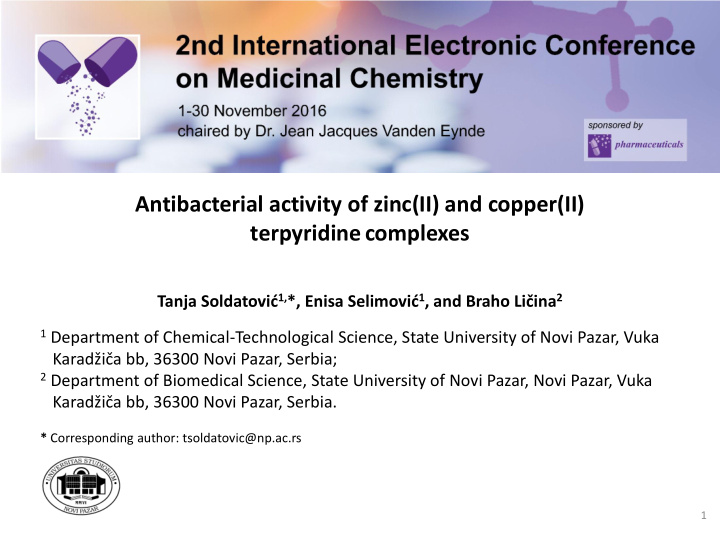



Antibacterial activity of zinc(II) and copper(II) terpyridine complexes Tanja Soldatovi ć 1, *, Enisa Selimovi ć 1 , and Braho Li č ina 2 1 Department of Chemical-Technological Science, State University of Novi Pazar, Vuka Karadžiča bb, 36300 Novi Pazar, Serbia; 2 Department of Biomedical Science, State University of Novi Pazar, Novi Pazar, Vuka Karadžiča bb, 36300 Novi Pazar, Serbia. * Corresponding author: tsoldatovic@np.ac.rs 1
Antibacterial activity of zinc(II) and copper(II) terpyridine complexes Cl Cl N N N N Cu Zn N N Cl Cl 2
Abstract: Zinc(ll) and copper(II) complexes with organic molecules are used in clinical medicine, e.g. (i) complex of zinc(ll) acetate with erythromycin is used for ache therapy, (ii) copper chelating agents were developed to treat Wilson disease, an autosomal recessive genetic disorder that causes copper accumulation primarily in the liver. In general, organic ligands can contribute to better transport of metal ions through the lipophillic regions of cell membranes. However, it is also possible that some metal complexes are not able to reach their site of action in sufficient concentration due to their decreased solubility. Antibacterial activity of model [ZnCl2(terpy)] and [CuCl2(terpy)] complexes was tested against seven strains of bacteria. The complexes were more effective against Gram-positive than Gram-negative bacteria. Between complexes, stronger effect was observed for [CuCl2(terpy)] complex. The best effect was exhibited against Sarcina lutea (5 mg/ml). Escherichia coli showed low sensitivity to both complexes. Results of the study of the antibacterial activity suggest an absence of permeability of the complexes through the membrane proteins. Keywords: Zinc(II); Copper(II); Biomolecules; Antibacterial activity 3
Introduction Zinc(ll) and copper(II) complexes with organic molecules are used in clinical medicine, e.g. complex of zinc(ll) acetate with erythromycin is used for ache therapy [1]. Copper chelating agents were developed to treat Wilson disease, an autosomal recessive genetic disorder that causes copper accumulation primarily in the liver. The same agents were investigated for their capacity to control angiogenesis and to impair cancer growth and metastasis [2]. In general, biomolecules can contribute to better transport of metal ions through the lipophillic regions of cell membranes [3]. Our focus is to investigate the interaction between zinc and copper and bio-ligands in proteins environment. We are also interested in studies related to the biological activity and medical applications of model Zn(II) and Cu(II) complexes structurally similar to catalytic centres in metalloenzymes. 4
Results and discussion Antibacterial activity Antibacterial activity of [ZnCl 2 (terpy)] and [CuCl 2 (terpy)] complexes was tested against seven strains of bacteria. The results are presented in Table 1. The complexes were more effective against Gram-positive than Gram-negative bacteria. 5
Tabele 1 . Antibacterial activity of [ZnCl 2 (terpy)] and [CuCl 2 (terpy)] complexes [ZnCl 2 (terpy)] [CuCl 2 (terpy)] MIC a MBC b Bacteria MIC MBC Bacillus subtilis 10 >20 10 10 Bacillus subtilis ATCC 6633 >20 20 5 10 Staphylococcus aureus >20 >20 > >20 Staphylococcus aureus 10 20 10 20 ATCC 25923 Sarcina lutea 5 >20 1.25 5 Escherichia coli 10 >20 > >20 Escherichia coli ATCC 10 >20 10 >20 25922 a Minimal inhibitory concentration (MIC). b Minimum bactericidal concentration (MBC) values are given as mg/ml. 6
The most active complexe was [CuCl 2 (terpy)] complex (Table 1). The best effect was exhibited against Sarcina lutea (5 mg/ml). Escherichia coli showed low sensitivity to both complexes. The study of the antibacterial activity suggests an absence of permeability of the complexes through the membrane proteins. Similar studies have shown that two new synthesized Cu(II) and Zn(II) complexes with xylitol have antibacterial effect against P. aeruginosa and C. albicans . Both copper and zinc complexes presented higher MIC against P. aeruginosa than the free xylitol, showing that these complexes could be better local antibacterial compounds than xylitol [4]. The square-pyramidal [Cu(lmx)(phen)(NO 3 )]·5H 2 O has shown minimum inhibitory concentration (MIC) in various E. coli strains and comparison with free lomefloxacin indicated that the Cu(II) complex is an antimicrobial agent that is as efficient as the free antibiotic but strongly suggested that the cell intake route of both species is different [5]. 7
Conclusions In conclusion, this study demonstrated stronger antibacterial activity of [CuCl 2 (terpy)] than [ZnCl 2 (terpy)]. This can be in correlation with a stronger affinity of Cu(II) for biomolecules. Absence of permeability of the proteins through cell membrane is probably due to the low thermodynamic stability of the prepared complexes and their dissociation in the solution. 8
Acknowledgments The authors gratefully acknowledge financial support from State University of Novi Pazar, Novi Pazar, Republic Serbia and T. Soldatović also gratefully acknowledges financial support from Ministry of Education, Science and Technological Development, Republic of Serbia (Project No. 172011) Reference [ 1] C. L. Feucht, B. S. Allen, D. K. Chalker, J. Am. Acad. Dermatol., 3(1980) 483. [2] European Association for Study of Liver, J. Hepatol. 56 (2012) 671. [3] R. B. Martin" in Metal lons in Biological Systems, Vol. 20, H. Sigel, Ed. Marcel Dekker, New York and Basel, 1986. [4] E. Santi, G. Facchina, R. Faccio, R.P. Barroso, A.J. Costa-Filho, G. Borthagaray, M. H. Torre, J. Inorg. Biochem. 155 (2016) 67. [5] P. Fernandes, I. Sousa, L. Cunha-Silva, M. Ferrerira, B. de Castro, E.F. Pereira, M.J. Feio, P. Gameiro, J. Inorg. Biochem. 131 (2014) 21. 9
Recommend
More recommend